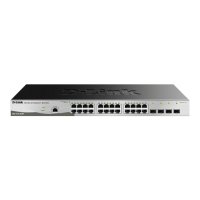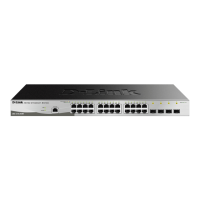4 Web-based Switch Configuration D-Link Smart Managed Switch User Manual
66
L2 Functions > Multicast > IGMP Snooping
With Internet Group Management Protocol (IGMP) snooping, the Smart Managed Switch can make
intelligent multicast forwarding decisions by examining the contents of each frame’s Layer 2 MAC header.
IGMP snooping can help reduce cluttered traffic on the LAN. With IGMP snooping enabled globally, the
Smart Managed Switch will forward multicast traffic only to connections that have group members attached.
The default IGMP Snooping version is v3, which works compatible with IGMP versions v1 and v2.
The DGS-1210 series support IGMP v1/v2/v3 awareness. And the IGMP v3 awareness means that we do
support IGMP v3 snooping, in other words, switch can read/understand the IGMP control packet which is
version3. The Switch still can based on its report/leave packet to do the correct behavior. But from the RFC
point of view, full IGMP v3 means that it should support source filtering and it’s not possible to support on the
L2 switch.
The settings of IGMP snooping is set by each VLAN individually.
Figure 4.72 – L2 Functions > Multicast > IGMP Snooping
By default, IGMP is disabled. If enabled, the IGMP Global Settings will need to be entered:
Host Timeout (130-153025 sec): This is the interval after which a learned host port entry will be purged. For
each host port learned, a 'Port Purge Timer' runs for 'Host Port Purge Interval'. This timer will be restarted
whenever a report message from host is received over that port. If no report messages are received for 'Host
Port Purge Interval' time, the learned host entry will be purged from the multicast group. The default value is
260 seconds.
Robustness Variable (2-255 sec): The Robustness Variable allows adjustment for the expected packet loss
on a subnet. If a subnet is expected to be lossy, the Robustness Variable may need to be increased. The
Robustness Variable cannot be set to zero, and it SHOULD NOT be. Default is 2 seconds.
Query Interval (60-600 sec): The Query Interval is the interval between General Queries sent. By adjusting
the Query Interval, the number of IGMP messages can be increased or decreased; larger values will cause
IGMP Queries to be sent less often. Default value is 125 seconds.
Router Timeout (60-600 sec): This is the interval after which a learned router port entry will be purged. For
each router port learned, a 'Router Port Purge Timer' runs for 'Router Port Purge Interval'. This timer will be
restarted whenever a Query control message is received over that port. If there are no Query control
messages received for 'Router Port Purge Interval' time, the learned router port entry will be purged. Default
is 260 seconds.
Last Member Query Interval (1-25 sec): The Last Member Query Interval is the Max Response Time
inserted into Group-Specific Queries sent in response to Leave Group messages, and is also the amount of
time between Group-Specific Query messages. This value may be adjusted to modify the "leave latency" of
the network. A reduced value results in reduced time to detect the loss of the last member of a group. Default
is 1 second.
Max Response Time (10-25 sec): The Max Response Time specifies the maximum allowed time before
sending a responding report message. Adjusting this setting effects the "leave latency", or the time between
the moment the last host leaves a group and when the multicast server is notified that there are no more
members. It also allows adjustments for controlling the frequency of IGMP traffic on a subnet. Default is 10
seconds.

